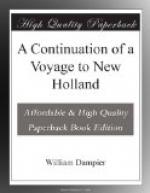The Malayans here kill all the Europeans they can.
In the dry season you must search for it in standing ponds or gulleys, where the wild buffaloes, hogs, etc. resort every morning and evening to drink; where you may lie and shoot them, taking care that you go strong enough and well-armed against the natives upon all occasions. For though there are no inhabitants near this place yet the Malayans come in great companies when ships are here; and if they meet with any Europeans they kill them, of what nation soever they be, not excepting the Portuguese themselves. It is but two years since a Portuguese ship riding here had all the boat’s crew cut off as they were watering; as I was informed by the Dutch. Here likewise is plenty of fish of several sorts, which may be caught with a seine; also tortoise and oysters.
From the north-east point of this bay, on the north side of the island, the land trends away north-north-east for four or five leagues; afterward north-east or more easterly; and when you are fourteen or fifteen leagues to the eastward of Babao you come up with a point that makes like Flamborough Head, if you are pretty nigh the land; but if at a distance from it on either side it appears like an island. This point is very remarkable, there being none other like it in all this island. When you are abreast of this point you will see another point about four leagues to the eastward; and when you are abreast of this latter point you will see a small island bearing east or east by north (according to your distance from the land) just rising out of the water: when you see it plain you will be abreast of a pretty deep sandy bay, which has a point in the middle that comes sloping from the mountains with a curious valley on each side: the sandy bay runs from one valley to the other. You may sail into this bay, and anchor a little to the eastward of the point in twenty fathom water, half a mile from the shore, soft oaze. Then you will be about two leagues from the west point of the bay, and about eight leagues from the small island before mentioned, which you can see pretty plain bearing east-north-east a little northwardly. Some other marks are set down in the foregoing chapter. In this sandy bay you will find fresh water in two or three places. At spring tides you will see many ripplings, like shoals; but they are only eddies caused by the two points of the bay.
We saw smokes all day up in the mountains, and fires by night, at certain places where we supposed the natives lived, but saw none of them.
The tides ran between the two points of the bay, very strong and uncertain: yet it did not rise and fall above nine foot upon a spring tide: but it made great ripplings and a roaring noise, whirling about like whirlpools. We had constantly eddy tides under the shore, made by the points on each side of the bay.
Laphao, A Portuguese settlement, described.




